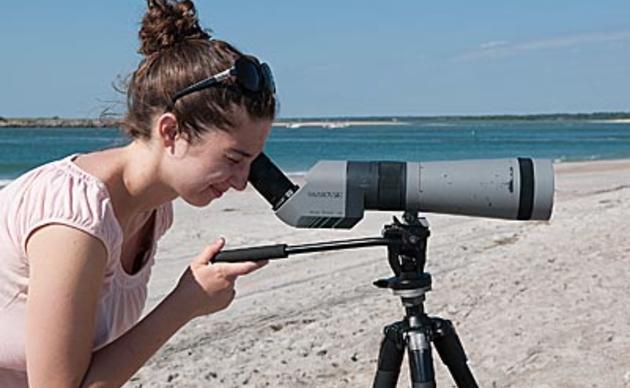Coastal Threats
With coastal real estate in high demand, attempts to modify, protect or fortify shorelines have increased. Unfortunately, these man-made efforts, including hardened structures like terminal groins, inlet modification and beach nourishment projects, upset the natural life cycle and ecosystem of the shore. As a result, birds have difficulty adapting to these unnatural changes and the loss of their natural habitats.
Threat to Coastal Birds
Take, for example, Red Knots. The decline in Red Knots along the Atlantic coast has been called one of the most precipitous declines of any bird species. The subspecies that occurs along the Atlantic coast once numbered 100,000-150,000; fewer than 30,000 remain today. This led to a proposal for emergency listing under the Endangered Species Act for fear of extinction.
Populations of Sanderlings, the ubiquitous shorebird of ocean beaches, have declined by as much as 80% since the 1970s. Roseate Terns and Piping Plovers are listed under the Endangered Species Act. Other species of terns, American Oystercatchers, and Black Skimmers have special conservation status in most Atlantic coast states, and more coastal bird species are experiencing population declines or are facing significant threats from habitat loss and degradation.
Habitat Loss
With each passing season, more and more habitats that coastal birds require are being lost. Sea level rise and the desire to stabilize dynamic shorelines threaten the habitat birds need to survive. The challenges to these birds and their long-term survival are real and quite serious. Continued action and commitment are necessary to secure a future for these birds and their habitats.
The significance of these bird populations and the need to protect their habitats cannot be ignored. This is evident by the significant number of Important Bird Areas located on the coastal plain. Important Bird Areas in the coastal plain amount to nearly 3.2 million acres, of which about 880,000 acres are open-ocean.
Stronghold in North Carolina
The North Carolina coast is a stronghold for nesting waterbirds, shorebirds and waterfowl. In addition, the coastal plain has a great diversity of habitat types that support significant assemblages of birds, such as barrier island beach, tidal marsh, Carolina bay or pocosin, bottomland hardwood forest, cypress-tupelo-gum swamp forest and others.
Thirty-three of the Important Bird Areas in the coastal plain are significant waterbird nesting sites. Statewide surveys for waterbird species have been conducted regularly for more than 25 years. The distribution of waterbird nesting sites, the abundance of waterbirds nesting on these sites, and the state population of these species are well known.
The importance of these coastal species is also indicated by their inclusion on the Audubon NC conservation plan. Twenty-one coastal species are given priority status.
Priority Species included in the Audubon North Carolina Coastal Plain Conservation Plain include:
- American Oystercatcher
- Red Knot
- Piping Plover
- Wilson's Plover
- Western Sandpiper
- Semipalmated Sandpiper
- Sanderling
- Black Skimmer
- Least Tern
- Common Tern
Responsibility Species included in the Audubon North Carolina Coastal Plain Conservation Plain include:
- Brown Pelican
- Royal Tern
- Sandwich Tern
- Gull-billed Tern
- Great Egret
- Snowy Egret
- Little Blue Heron
- Tricolored heron
- White Ibis
- Glossy Ibis
Did this issue get you fired up? Sign-up for our NC Action Alert network to stay informed as we work to protect birds in North Carolina.
How you can help, right now
Donate to Audubon
Help secure the future for birds at risk from climate change, habitat loss and other threats. Your support will power our science, education, advocacy and on-the-ground conservation efforts.
Sign Up For Our eNewsletter
Keep up-to-date on all that happens with Audubon North Carolina's research, events and volunteer opportunities.




